
The .308 Winchester is a smokeless powder rimless bottlenecked rifle cartridge widely used for hunting, target shooting, police, military, and personal protection applications globally. It is similar, but not identical, to the 7.62×51mm NATO cartridge.

The .460 Weatherby Magnum is a belted, bottlenecked rifle cartridge, developed by Roy Weatherby in 1957. The cartridge is based on the .378 Weatherby Magnum necked up to accept the .458-inch (11.6 mm) bullet. The original .378 Weatherby Magnum parent case was inspired by the .416 Rigby. The .460 Weatherby Magnum was designed as an African dangerous game rifle cartridge for the hunting of heavy, thick skinned dangerous game.
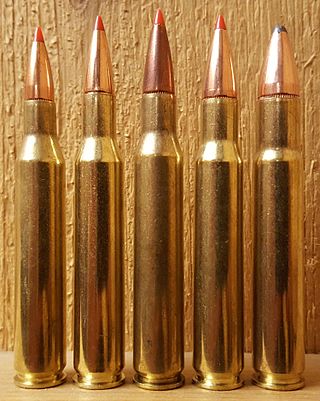
The .270 Winchester is a rifle cartridge developed by Winchester Repeating Arms Company in 1923 and it was unveiled in 1925 as a chambering for their bolt-action Model 54 to become arguably the flattest shooting cartridge of its day, only competing with the .300 Holland & Holland Magnum, also introduced in the same year.

The 7mm-08 Remington is a rifle cartridge that is almost a direct copy of a wildcat cartridge developed around 1958 known as the 7mm/308. As these names would suggest, it is the .308 Winchester case necked down to accept 7 mm (.284) bullets with a small increase in case length. Of cartridges based upon the .308, it is the second most popular behind only the .243 Winchester. However, the .308 is more popular than both. In 1980, the Remington Arms company popularized the cartridge by applying its own name and offering it as a chambering for their Model 788 and Model 700 rifles, along with a limited-run series within their Model 7600 pump-action rifles during the early 2000s.
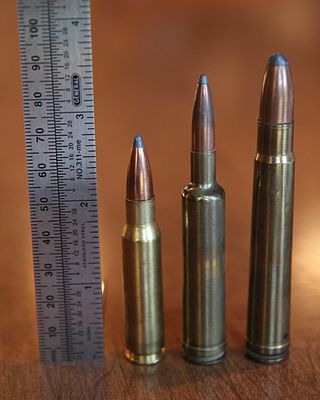
The .257 Weatherby Magnum is a .257 caliber (6.53 mm) belted bottlenecked cartridge. It is one of the original standard length magnums developed by shortening the .375 H&H Magnum case to approx. 2.5 in (64 mm). Of the cartridges developed by Roy Weatherby, the .257 Weatherby Magnum was known to have been his favorite, and the cartridge currently ranks third in Weatherby cartridge sales, after the .30-378 Weatherby Magnum and the .300 Weatherby Magnum.
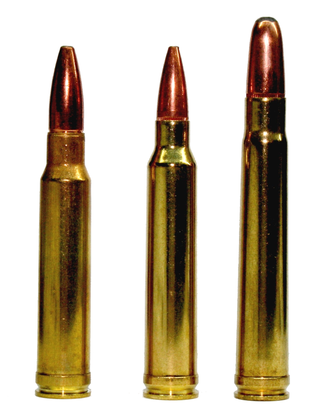
The .300 Winchester Magnum is a belted, bottlenecked Magnum rifle cartridge that was introduced by the Winchester Repeating Arms Company in 1963. The .300 Winchester Magnum is a magnum cartridge designed to fit in a standard rifle action. It is based on the .375 H&H Magnum, which has been blown out, shortened, and necked down to accept a .30 caliber (7.62 mm) bullet.
The .222 Remington Magnum was a short-lived commercially produced cartridge derived from the .222 Remington. Originally developed for a US military prototype Armalite AR-15 rifle in 1958, the cartridge was not adopted by the military, but was introduced commercially in sporting rifles.

The 7mm Remington Magnum rifle cartridge was introduced as a commercially available round in 1962, along with the new Remington Model 700 bolt-action rifle. It is a member of the belted magnum family that is directly derived from the venerable .375 H&H Magnum. The original purpose of the belted magnum concept taken from the .300 H&H Magnum and .375 H&H Magnum, was to provide precise headspace control, since the sloping shoulders, while easing cartridge extraction, were unsuitable for this purpose. Improved cartridge extraction reliability is desirable while hunting dangerous game, in particular when a fast follow-up shot is required. The 7mm Remington Magnum is based on the commercial .264 Winchester Magnum, .338 Winchester Magnum, and .458 Winchester Magnum, which were based on the same belted .300 H&H Magnum and .375 H&H Magnum cases, trimmed to nearly the same length as the .270 Weatherby Magnum.

The 8mm Remington Magnum belted rifle cartridge was introduced by Remington Arms Company in 1978 as a new chambering for the model 700 BDL rifle. The 8mm Remington Magnum's parent case is the .375 H&H Magnum. It is a very long and powerful cartridge that cannot be used in standard length actions, such as those that accommodate the .30-06 Springfield.
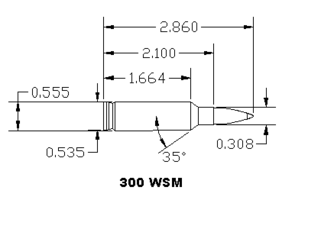
300 Winchester Short Magnum is a .30 caliber rebated rim bottlenecked centerfire short magnum cartridge that was introduced in 2001 by Winchester.
The .300 Remington Ultra Magnum, also known as the .300 Ultra Mag, 7.62×72mm or .300 RUM, is a 7.62 mm rifle cartridge introduced by Remington Arms in 1999. The .300 Remington Ultra Magnum is one of the largest commercially available .30 caliber magnums currently being produced. It is a beltless, rebated rim cartridge, capable of handling all large North American game, as well as long-range shooting. Among commercially produced .30-caliber rifle chamberings, the .300 Remington Ultra Magnum is second only to the .30-378 Weatherby Magnum in cartridge-case capacity.
The .300 H&H Magnum cartridge was introduced by the British company Holland & Holland as the Super-Thirty in June, 1925. The case was belted like the .375 H&H Magnum, and is based on the same case, as also is the .244 H&H Magnum. The belt is for headspace as the cases' shoulders have a narrow slope rather than an actual shoulder. More modern magnums continue this practice, but headspacing on the belt is not necessary with their more sharply angled shoulders. The cartridge was used by American shooter Ben Comfort to win the 1000-yard Wimbledon Cup Match at Camp Perry in 1935, and it was used again to win the international 1,000 yard competition in 1937. Winchester chambered the Model 70 in .300 Holland & Holland Magnum in 1937.
The .264 Winchester Magnum is a belted, bottlenecked rifle cartridge. Except for the .244 H&H Magnum and .257 Weatherby Magnum, it is the smallest caliber factory cartridge derived from the 2.85 in (72 mm) Holland & Holland belted magnum case. It was introduced in the late 1950s and early 1960s with the .338 Winchester Magnum and the .458 Winchester Magnum as one of a family of short-cased 2.5 in (64 mm) belted magnum cartridges developed by Winchester based on the .375 Holland & Holland parent case. It was officially introduced to the public by Winchester in 1959. After many years of dwindling use it began enjoying a mild resurgence in popularity in the mid-2000s among long range rifle enthusiasts and reloaders due to the high ballistic coefficient of the heavier 6.5mm bullets and increasing popularity of cartridges such as 6.5mm Creedmoor, .260 Remington, 6.5 Grendel, benchrest and wildcat cartridges in 6.5mm.

The .404 Jeffery is a rifle cartridge designed for hunting large, dangerous game animals, such as the "Big Five" of Africa. The cartridge is standardized by the C.I.P. and is also known as .404 Rimless Nitro Express. It was designed in 1905 by London based gunmaker W.J. Jeffery & Co to duplicate the performance of the .450/400 Nitro Express 3-inch in bolt-action rifles. The .404 Jeffery fired a bullet of .422 in (10.72 mm) diameter of either 300 gr (19 g) with a muzzle velocity of 2,600 ft/s (790 m/s) and muzzle energy of 4,500 foot-pounds force (6,100 N⋅m) or 400 gr (26 g) with a muzzle velocity of 2,150 ft/s (660 m/s) and 4,100 foot-pounds force (5,600 N⋅m) of energy. It is very effective on large game and is favored by many hunters of dangerous game. The .404 Jeffery was popular with hunters and game wardens in Africa because of its good performance with manageable recoil. By way of comparison, the .416 Rigby and .416 Remington Magnum cartridges fire .416 in (10.57 mm) bullets of 400 gr at 2,400 feet per second (730 m/s) with a muzzle energy of approximately 5,000 foot-pounds force (6,800 N⋅m). These cartridges exceed the ballistic performance of the .404 Jeffery but at the price of greater recoil and, in the case of the .416 Rigby, rifles that are more expensive.

The .270 Weatherby Magnum was the first belted magnum based on the .300 H&H Magnum to be developed by Roy Weatherby in 1943. The cartridge is short enough to function in standard-length long actions with a brass length of 2.549" or 64.74mm and an overall length of about 3.295".
The 270 Winchester Short Magnum or 270 WSM is a short magnum cartridge created by necking down the .300 Winchester Short Magnum and fitting it with a .277 caliber bullet. The correct name for the cartridge, as listed by the Sporting Arms and Ammunition Manufacturers' Institute (SAAMI), is 270 WSM, without a decimal point. It is a member of the Winchester Short Magnum family of cartridges.
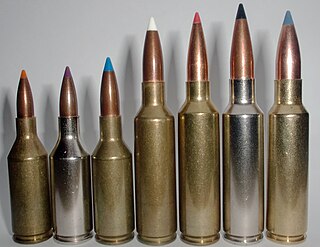
The .325 Winchester Short Magnum, commonly known as the 325 WSM, is an 8mm caliber rebated rim bottlenecked centerfire short magnum medium bore cartridge. The cartridge was introduced by Winchester Ammunition in 2005.
Remington introduced the 7mm Short Action Ultra Magnum (SAUM) cartridge in 2002 to compete with the 7mm Winchester Short Magnum cartridge. It was designed specifically for the Remington Model Seven Magnum rifle, and intended primarily for long-range hunting use. The difference in velocity between the 7mm SAUM cartridge and the 7mm Winchester Short Magnum (WSM) is less than 50 feet per second; they are almost ballistic twins. Both the 7mm SAUM and the 7mm WSM achieve optimal ballistic results when using bullet weights from 120 to 160 grains.
Remington Ultra Magnum, or RUM, refers to a "family" of cartridges developed between 1999 and 2002 by Remington Arms. All of the RUM cartridges are based on the .404 Jeffery non-belted magnum cartridge. There is a long-case line, as well as a shortened version designed to fit a short rifle action. The long case is very large and provides performance that exceeds existing commercial magnums, such as the .300 Winchester Magnum and .300 Weatherby Magnum.
Nosler produces six different hunting cartridges. The first to be introduced was .26 Nosler, followed by .28 Nosler, .30 Nosler, .33 Nosler, .22 Nosler, and .27 Nosler.












